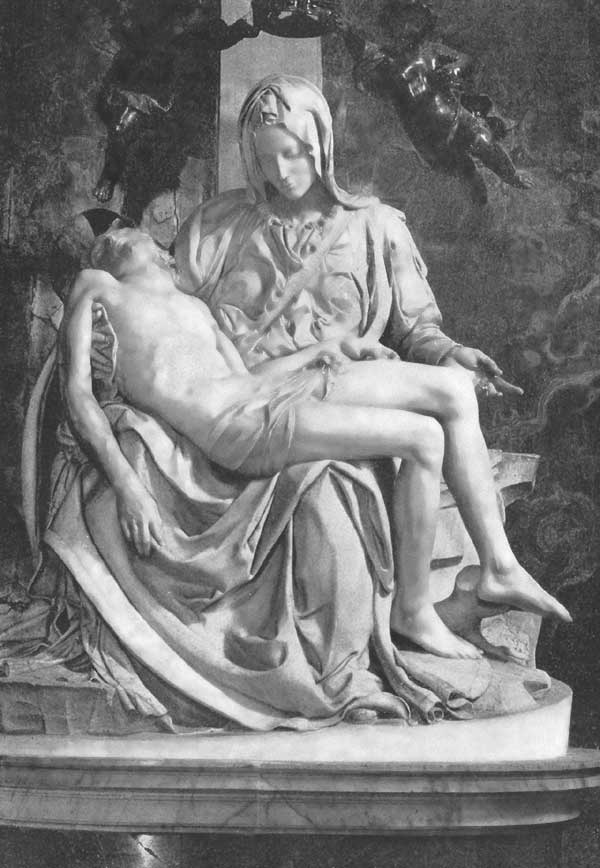VI
THE PIETÀ
In the busy years of Christ’s ministry we do not read of his often being with his mother Mary. He was going about the country preaching and healing, and gave himself wholly to his mission. Yet we know that the love between mother and son was constant and unchanging. From beginning to end she always had confidence in his power, and his tender care for her was among his last thoughts.
On the dreadful day of the Crucifixion, the mother was found standing by the cross, with her sister and Mary Magdalene. “When Jesus therefore saw his mother, and the disciple standing by, whom he loved [that is, St. John], he saith unto his mother, Woman, behold thy son! Then saith he to the disciple, Behold thy mother! And from that hour that disciple took her unto his own home.”[14]
We can imagine the mother’s anguish in seeing her son suffer this cruel and ignominious death. He had lived only to do good, and now he was dying an innocent sacrifice to his enemies. At such a moment the mother might truly feel that a sword was piercing her soul, as the old man Simeon[15] had once prophesied of her, many years before.
“Wearied was her heart with grieving,
Worn her breast with sorrow heaving,
Through her soul the sword had passed.
“Ah! how sad and broken-hearted
Was that blessed mother, parted
From the God-begotten One!
“How her loving heart did languish
When she saw the mortal anguish
Which o’erwhelmed her peerless Son.”[16]
Time passed, and Jesus now being dead, his friends were permitted by the governor to remove him from the cross. Joseph of Arimathea took the lead, as he was to lay the body in a new sepulchre recently made in his garden. Nicodemus was also there, bringing linen and spices for the burial, and the loving women lingered to see these preparations.
We can imagine how they might all stand aside to make room for the mother Mary. Perhaps, indeed, they would withdraw a little way to leave her for a moment alone with her son. The years seem to melt away, and again she gathers him in her lap as when he was a babe. All the motherly tenderness which she has had long pent up in her heart now overflows. If she has sometimes felt a little lonely that in his manhood he no longer needed her care, she forgets it now. He is still her child.
The marble group by Michelangelo interprets such a moment for us. The Italians call the subject the Pietà, which means compassion, but the name scarcely expresses all the emotions of the mother. [35]She seems as strong and young as when she brooded over her babe in the Bethlehem manger. “Purity enjoys eternal youth” was the sculptor’s explanation to those who objected.
THE PIETÀ. St. Peter’s, Rome.
Across her capacious, motherly lap lies the slender, youthful figure of the dead Christ. The head falls back, and the limbs are relaxed in death. Suffering has left no trace on his face. The nail prints in hands and feet, and the scar in the side, are the only signs of his crucifixion. The delicately moulded body is beautiful in repose.
The mother seems to find mysterious comfort in gazing upon her son. Perhaps his death has opened her eyes to the meaning of his life. If this is so, she cannot grieve. He has finished the work given him to do, and death is the beginning of immortality. So sorrow gives place to resignation. She is again the proud mother. The fond hopes with which she watched his childhood have been more than fulfilled. She extends her hand in a gesture which seems to say, “Behold and see.”
It is said that certain Lombards, passing through the church where the Pietà stood, ascribed the work to a Milanese sculptor named Cristoforo Solari. Michelangelo, having overheard them, shut himself up in the chapel, and chiselled his name upon the girdle which crosses the Madonna’s breast and supports her flowing garments. His name is not found on any of his other works, and we can understand why he felt proud of such a masterpiece. Though made when on the very threshold of his career, it [36]was never surpassed even in his later years. Some other artist afterwards designed the two little bronze cherubs who hold a crown over the Madonna’s head. They are quite out of harmony with the impressive dignity of the figures below.
Michelangelo’s early love of Greek sculpture taught him many lessons, which were worked out in this group. It has, first of all, that perfect repose which was the leading trait in classic art. There is nothing strained or violent in the positions. Besides this, the figures are so arranged that on all sides, as in a Greek statue, the lines are beautiful and harmonious.
But the subject itself is one which would have been too sad for the pleasure-loving Greek. To the pagan the thought of death was something to be avoided. Michelangelo’s statue teaches the highest lesson of religious faith,—the beauty of resigned sorrow and the sublimity of sacrificing love.
[14] John, chapter xix. verses 26, 27.
[15] Luke, chapter ii. verse 35.
[16] From Stabat Mater.

